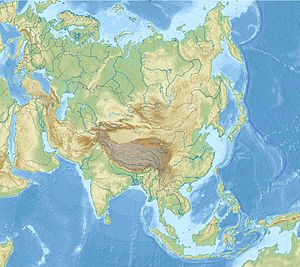This article may require cleanup to meet Wikipedia's quality standards. The specific problem is: Overload of images in non-relevant sections. (August 2022) |
Herat
هرات | |
|---|---|
Left-to-right from top: Great Mosque of Herat, Herat Citadel, Herat University, panoramic view of Musalla complex, Jama Mosque exterior, skyline of Herat city | |
| Nickname: "The Pearl of Khorasan"[1] | |
| Coordinates: 34°20′31″N 62°12′11″E / 34.34194°N 62.20306°E | |
| Country | |
| Province | Herat |
| Area | |
• Total | 182 km2 (70 sq mi) |
| [2] | |
| Elevation | 920 m (3,020 ft) |
| Population | |
• Estimate (2021) | 592,902[3] |
| Time zone | UTC+4:30 (Afghanistan Standard Time) |
| Postal code | 30XX |
| Climate | BSk |
Herāt (/hɛˈrɑːt/;[4] [Dari]) is an oasis city and the third-largest city in Afghanistan.[5] In 2020, it had an estimated population of 574,276, and serves as the capital of Herat Province, situated south of the Paropamisus Mountains (Selseleh-ye Safēd Kōh) in the fertile valley of the Hari River in the western part of the country. An ancient civilization on the Silk Road between West Asia, Central Asia, and South Asia,[6] it serves as a regional hub in the country's west.
Herat dates back to Avestan times and was traditionally known for its wine. The city has a number of historic sites, including the Herat Citadel and the Musalla Complex. During the Middle Ages, Herat became one of the important cities of Khorasan, as it was known as the Pearl of Khorasan.[7] After its conquest by Tamerlane, the city became an important center of intellectual and artistic life in the Islamic world.[8] Under the rule of Shah Rukh, the city served as the focal point of the Timurid Renaissance, whose glory is thought to have matched Florence of the Italian Renaissance as the center of a cultural rebirth.[9][10] After the fall of the Timurid Empire, Herat has been governed by various Afghan rulers since the early 18th century.[11] In 1716, the Abdali Afghans inhabiting the city revolted and formed their own Sultanate, the Sadozai Sultanate of Herat. They were conquered by the Afsharid Persia in 1732.
After Nader Shah's death and Ahmad Shah Durrani's rise to power in 1747, Herat separated from Persia became part of Afghanistan.[11] It became an independent city-state in the first half of the 19th century, facing several Qajar Iranian invasions until being incorporated into Afghanistan in 1863.[12] The roads from Herat to Iran (through the border town of Islam Qala) and Turkmenistan (through the border town of Torghundi) are still strategically important. As the gateway to Iran, it collects high amount of customs revenue for Afghanistan.[13] It also has an international airport. Following the 2001 war, the city had been relatively safe from Taliban insurgent attacks.[14] In 2021, it was announced that Herat would be listed as a UNESCO World Heritage Site.[15] On 12 August 2021, the city was seized by Taliban fighters as part of the Taliban's summer offensive.[16]
The area of Herat, along with areas like Piranshahr, Damghan and Aleppo, are noted to be sites for archaeological interests and exploration.[17][18][19][20][21][22][23]
- ^ "Hadith - Book of Tribulations - Sunan Ibn Majah - Sunnah.com - Sayings and Teachings of Prophet Muhammad". sunnah.com. Archived from the original on 12 November 2020. Retrieved 24 December 2020.
- ^ "OCHA - February Humanitarian Bulletin" (PDF). Archived (PDF) from the original on 12 March 2017. Retrieved 25 January 2018.
- ^ "Estimated Population of Afghanistan 2021-22" (PDF). National Statistic and Information Authority (NSIA). April 2021. Archived (PDF) from the original on 24 June 2021. Retrieved 21 June 2021.
- ^ Herat - Definition and More from the Free Merriam-Webster Dictionary Archived 2013-10-06 at the Wayback Machine. Merriam-webster.com (2012-08-31). Retrieved on 2013-07-12.
- ^ Podelco, Grant (9 April 2008). "Afghanistan: Herat's Treasures Can't Compensate For Atmosphere Of Fear". Radio Free Europe/Radio Liberty.
- ^ "Archived copy". Archived from the original on 30 April 2019. Retrieved 26 July 2021.
{{cite web}}: CS1 maint: archived copy as title (link) - ^ Cite error: The named reference
Mustawfiwas invoked but never defined (see the help page). - ^ "The Art of the Timurid Period (ca. 1370–1507)". Archived from the original on 25 November 2016. Retrieved 7 November 2016.
- ^ Periods of World History: A Latin American Perspective - Page 129
- ^ The Empire of the Steppes: A History of Central Asia - Page 465
- ^ a b Singh, Ganda (1959). Ahmad Shah Durrani, father of modern Afghanistan Archived 2016-05-15 at the Wayback Machine. Asia Publishing House, Bombay. (PDF version 66 MB Archived 7 February 2013 at the Wayback Machine)
- ^ Cite error: The named reference
:0was invoked but never defined (see the help page). - ^ "Bomb blast hits west Afghan city". BBC News. 3 August 2009. Archived from the original on 30 September 2009. Retrieved 26 March 2010.
- ^ Hughes, Roland (4 August 2016). "Do tourists really go to Afghanistan?". BBC News. Archived from the original on 1 May 2018. Retrieved 21 July 2018.
- ^ "Herat City to Be Listed as UNESCO World Heritage Site". TOLOnews. Retrieved 4 July 2021.
- ^ "Taliban take Herat, Afghanistan's third-largest city, as they push towards Kabul".
- ^ "Piranshahr in need of archaeological museum: Official". 6 September 2022.
- ^ "8,000 years old artifacts unearthed in Iran". 7 January 2019.
- ^ "Iranian archeologists hail find of relics built more than 5500 years ago". 18 November 2023.
- ^ Ahmadpour, Afsaneh; Kamkar Rouhani, Abolghasem; Ahmadi, Reza (2016). "Archaeological exploration of Tappeh Hissar, Damghan using forward and inverse modeling of Ground-Penetrating Radar data". Journal of Research on Archaeometry. 2: 1–16. doi:10.29252/jra.2.1.1.
- ^ "Areia Antiqua. Ancient Herat". Staatliche Museen zu Berlin. Retrieved 26 August 2024.
- ^ "The State of Cultural Heritage in the Ancient City of Aleppo".
- ^ "UNOSAT".








